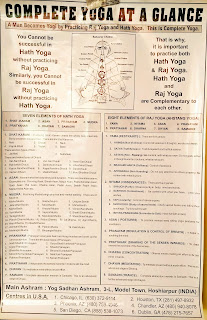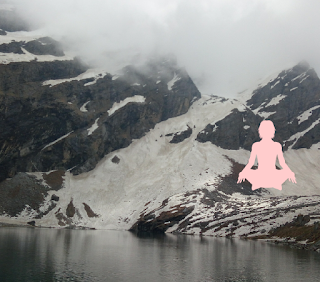The Science of Yoga
The Science of Yoga
The science of yoga has its
origin thousands of years ago; and Shiva is seen as the first Adiyogi. Yoga was being practiced in the pre-Vedic
period and inner-world scientist maharishi Patanjali arranged existing yoga
practices in the Patanjali yoga sutras 5000 years ago. The word yoga means
union, referring to the union with the supreme soul and the process by which
the human spirit is brought near to the super consciousness. Since the
inception of the International Yoga day on June 21, 2015; the opinion about
this science are shifted fast, yoga today is widely accepted as a wellness
science by and for everyone. People are increasingly turning to yoga for
relaxing, soothing effects but more for solving their health issues. Yoga is an
invaluable gift of the ancient Indian tradition and it acts, embodies unity of
the mind and body to balance thought and action, restraint and fulfilment,
setting harmony between man and nature in a holistic approach to health and
well-being.
Yoga is for the benefit of all and during a yoga session
incapability is no longer a barricade on the way to keep your goals alive.
Along with blissful state of mind and your physical well-being with fine blend
of soul; The practice of yoga comprises of Asanas (postures), pranayamas and
mudras that put more importance on the fasciae connective tissues, organs and
tendons, bones, bone marrow and the seven major energy centres known as chakras
or glands and less emphasis on muscles development. Yogic practices should be
performed slowly, in a tranquil manner, with consciousness of the body and
breath, and should end with a meditation in order to gain the desired results.
Immense bliss is generated, and the person feels intense peace in a state of
meditation.
Bones are filled
with red marrow in the early stage of life, and over time the bones gradually
hollow out and fill with fat, the consequences of which, that the body produces
less blood cells and become brittle or losing its flexibility and susceptible
to fracture.
Tendon: - a cord or band of dense, tough, inelastic, white,
fibrous tissue and serving to connect a muscle with a bone or part. Marrow: - a
soft, fatty, vascular tissue in the interior cavities of bone essential part is
manifesting strength and vitality. Bone marrow is long bones such as limb
bones, a cavity called bone marrow cavity is filled with a soft and semisolid
fatty neurovascular tissue termed as bone marrow.
Each organ has a fascia layer, as the most pervasive
tissues in the body of which covers and protects the vital organs. Stimulation of
organs requires more oxygen in to fascia which happens when appropriate
exercise has been done. Fascia has been given a specific name after different
organs of the body. e.g. In the lung it is known as pleura a delicate serous
membrane put in each lung in mammals and folded back as a lining of the
corresponding side of the thorax. Each lung is enclosed in a double walled sac
while Pericardium membranous sac encloses the heart. Stomach is a sac like
enlargement of the alimentary canal comprising with major vital organs and
fasciae which covers whole organs have shielding, connective, renewing and
nourishing stuffs, and showing energising cavities for the organs.
The pleasure of today and the brilliance of future are
totally depending on righteous deeds which lead to optimistic traits of life.
So one needs to comprehend the body, owing to their subtle nature of which
remain latent and unknown. When you constantly to do yoga, in the morning, just
20 minutes, you will see evidence of it. Body foretells the onset of any
diseases. While ascribing destiny man makes his own destiny.
Every nerve of the body is associated with spinal cord, all
organs, micturition (the act of passing urine; urination), digestion,
blood-circulation, respiration are all controlled by this spinal cord. Vajra
asana shapes the spinal cord and brings closer to health abundance.
Vajra asana:
Sit with the legs folded back and keep the soles of the
feet on both sides of the anus while keeping the knees together and meantime
keep palms on the knees and remembering head, neck and waist should be straight
in the line. Look front, the body’s whole weight is put on the knees and ankles
while the arms and shoulders are relaxed.
Benefits:
Performing immediately after a meal it offers good
digestion, if done for ten minutes or more. Myalgia (muscular pain) in the
knees, legs, toe and thighs disappears. Flatulence (generating gas in the
alimentary canal, as food creates an accumulation of gas) and sciatica
(neuralgia along the course of the sciatic nerve, most often with pain
radiating into buttock and lower limb, most commonly due to herniation of a
lumber disk) disappears as you do in the morning or evening.
Vajra asana is beneficial for meditation as stomach and all
part of the body remain stress free and enhance brain’s efficiency.
Padam
asana:
Find a quiet place and sit down
on the ground with legs straight in front.
Fold the legs by placing the left
foot on the right thigh and the right foot on left thigh.
Place both the heels as near to
the abdomen as possible while knees touch the ground.
Rest hands on the knees with the
palms facing upwards with the index finger touching the middle portion of the
thumb, spine lengthening up.
Shoulders should be remain loose
and arms fairly straight.
Breathe naturally.
Sit in this asana for as long as
possible.
Benefits:
Padam asana strengthens legs,
waist, shoulders and spine resulting in good posture. Enhances the respiration
rhythmically and balances the mind. It can help ladies with menstrual
discomfort and sciatica. As well as restoring energy levels.
Nadi
shudhi pranayama:
Close the right nostril with
thumb of the right hand and breathe in slowly and filling the stomach with air
as it comes from of your left nostril and be ensure stomach will be expand
outside as filling the air in it.
Close the right nostril with
right thumb and breathe in and out from left nostril for 10 breathes ensure the
stomach expands during inhalation and contracts during exhalation.
Now close the left nostril with
ring finger and small finger as well and hold the breath comfortably.
Exhale slowly from the right
nostril by keeping your left nostril closed with small and ring finger. Now
breathe in and out from the right nostril for 10 breathes. Then close the right
nostril and hold the breath comfortably and then exhale slowly from the left
nostril.
Repeat all the above steps three
times and ensure that the last breath you take is exhaling from your left
nostril.
Relax for some time.
Benefits:
Quite safe as compare to other
types of the pranayama as it cures all types of problems such like as
constipation, falling hairs, eyes problem, concentration, laziness, back pain,
stomach problems and nervous system. This pranayama remove all diseases as it
purifies the Nadis, improve digestion and blood-circulation and provides
enthusiasm.
Meditation
Meditation offers way to bring
the experience of true nature of your wisdom. Meditation yields a significant
experiences of calm and well-being within five minutes because the cycle of
breath links you to the rhythms of creation within you and with the cosmic
prana energy. Gradually, you will get a feel for the act of sitting in silent
stillness; and would increase the time limits further easily enthusiastically. One
simple breathing observation exercise that one must be do twice a day.
§ Find
a quit place and sit down in comfortable asana, spine lengthening up.
§ Close
your eyes and bring your attention to the flow of your breathing and be aware
of the feeling of the air hot or cold against your nostrils above lips and
below nostrils as you inhale.
§ Keep
your attention on the flow of your breathing and following your breath and
exhale slowly.
Breathing awareness is the
starting exercise in yoga to taming the mind and must be do in the morning and
at night before going to sleep would help you to connect with yourself.
Advanced meditation come with mudras are yoni mudra, Maha mudra, Shambhavi mudra,
ashwini mudra, kaki mudra and Khechari mudra. Pranayama: ujjayi, Sitkari,
sheetali, Bhastrika and Bhramari.





Very nice
ReplyDeleteVery nice Pranayama for digestive system
ReplyDelete